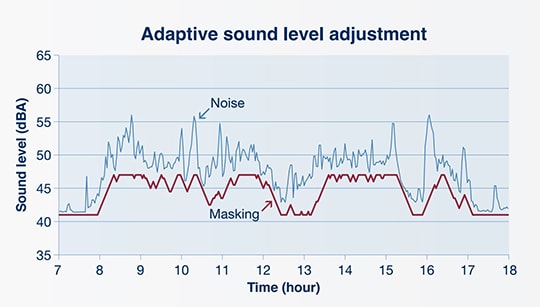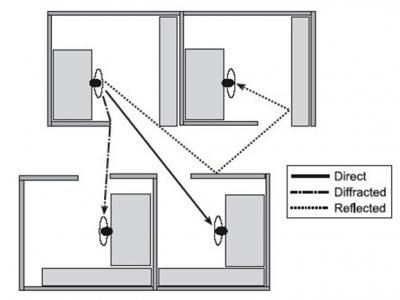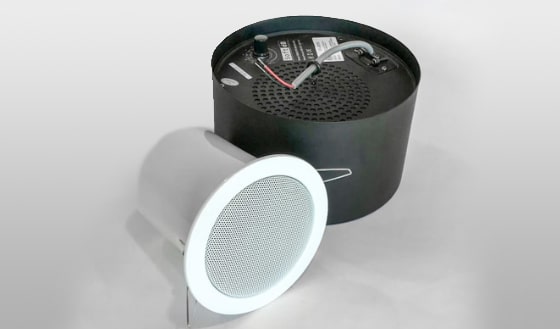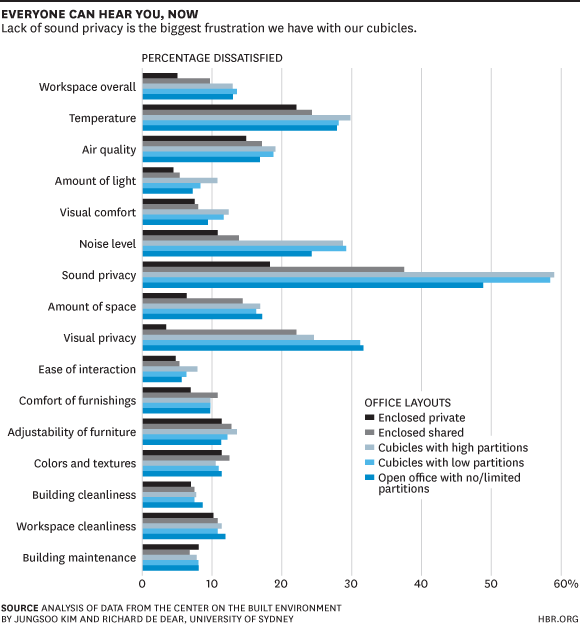Sound Masking Documentation & References
Architectural Specifications

- SmartSMS-NET sound masking system overview
- Performance and system features
- Sound masking generating system
- Adaptive volume control adjustment in open areas
- Paging and Music Broadcast Systems (Option)
- Target sound masking spectrum
- Validation method
- Standards test methods
- Certifications – ETL Listed 3191772
- Supplier
White Papers
How Sound Masking With Adaptive Volume Control Is Better Than Sound Masking With a Preset Timer Function
At NoiseCon 2017 in Grand Rapids, MI, Soft dB presented a scientific paper entitled Adaptive Volume Control for Sound Masking, written by Dr. Andre L’Esperance, et al. The paper demonstrates how the Adaptive Volume Control (AVC) feature, which allows the masking sound level to reactively vary between 42 and 45 dBA depending on ambient background noise, obtains similar levels of confidentiality and speech privacy compared to a sound masking system equipped only with a 45 dBA timer function.
Meanwhile, the real difference between the Adaptive Volume Control feature and the timer function for masking systems is seen in occupant acoustic comfort. A sound masking system featuring Adaptive Volume Control provides an unparallelled 50% improvement in occupant acoustic comfort during periods of moderate office activity, when compared to a timer function. Furthermore, if the upper limit of the AVC sound masking system is set to 48 dBA (CNRC-recommended upper limit) instead of 45 dBA, the level of acoustic comfort is maintained, but the confidentiality and speech privacy are improved by 15%.
How Sound Masking With Adaptive Volume Control Is Better Than Sound Masking With a Preset Timer Function

Direct-Field vs. Plenum Sound Masking Speakers: Marketing Hype and Reality
At the fall 2018 InterNoise conference in Chicago, Soft dB presented a scientific study based on measurable and repeatable experiments to demonstrate the reality, beyond the marketing hype. The conclusions of the study are very interesting:
- Spatial uniformity of the masking sound is better (more uniform) with a plenum system than a direct field
- In the case of a sound masking system in a plenum space with obstruction, the spatial uniformity is still better than a direct field system
Soft dB is a world leading sound masking system supplier and excels in both approaches. Direct field sound masking speakers make sense in some office configurations where the plenum height is limited or when paging/background music functionality is required. However, for all other applications, installing the speakers inside the plenum space will typically be a better option for sound masking efficiency and comfort.
References and Studies on Sound Masking Benefits
“Open plan offices have gradually become the predominant format of office space for a wide range of work activities. The main argument in favour of open plan offices is the expected reduced cost relative to closed offices with full height partitions. The cost savings may be a little reduced with the extra expense of meeting ‘acceptable’ speech privacy requirements. However, these additional costs are usually assumed to be small relative to the costs of decreased performance by distracted office workers. It is not possible to achieve ‘acceptable’ speech privacy if all office design parameters do not have near to optimum values. A successful open office should also include an optimum masking sound spectrum.”
The Acoustical Design of Conventional Open Plan Offices – Bradley, J.S
“When asked about their offices, 88% of respondents noted the quality of their work environment was important to job satisfaction and 84% reported that they accomplished their best work at the office. In fact, when asked if they would be willing to work an extra hour per day if they had a better working environment, 49% of respondents said yes.”
The 2006 US Workplace Survey – Gensler
“An ideal ambient noise level is approximately 45 dBA. If the noise level is much less, speech privacy will be substantially reduced. If it is much higher, the noise will be a source of annoyance and may reduce speech privacy because people will talk louder. The maximum noise level should therefore not exceed 48 dBA. Because it is important to achieve an ambient noise level within a very small range of levels, and because noise levels should also be evenly distributed throughout the office, this is usually best achieved using electronic masking noise. Of course, this also allows the spectrum, as well as the level, of the masking sound to be optimally set to maximize the speech privacy without undue disturbance.”
Criteria for Acoustic Comfort in Open-Plan Offices – Bradley, J. S.; Gover, B. N.
“The capital and operating costs for buildings account for 8%, while the human resources costs (salaries and benefits) represent 82%. In relative terms, office design choices are inexpensive and the costs of sound investments in design can be recouped quickly in the form of enhanced occupant satisfaction and performance.”
Workstation Design for the Open-Plan Office – Veitch, J. A., K. E. Charles, and G. R. Newsham. 2004.
Positive Impacts of Appropriate Speech Privacy and Acoustical Conditions on Office Workers
1. Ability To Focus On Tasks
2. Elimination Of Distractions
3. Reduction Of Stress
4. Error Rates/Accuracy
Using Sound Masking to Reduce the Radius of Distraction in Open Offices
“A significant improvement in objective speech privacy occurred after the installation of masking system. The radius of distraction reduced from 13 to 6 meters.”
“Appropriate masking is necessary to reach acceptable speech privacy between two neighbouring workstations.”
“After the change, all types of work were less distracted by noise.”
“The need for further acoustic improvements became negligible because major acoustic problems no longer existed after the installation of masking.”
Effects of sound masking on workers – a case study in a landscaped office – Valtteri Hongisto
Is Noise Ruining Your Open Plan Office?
“By adding a continuous, low-level ambient sound to an environment (such as white noise, which sounds similar to the sound of airflow), sound masking can help make conversations for listeners that aren’t intended to hear them unintelligible, and therefore much easier to ignore.”
Leveraging Sound Masking in Today's Workplace Design
“Sound masking systems can be used to add neutral background noise that will cover speech sounds and other distracting noises. Masking sound is an effective way to lower SII and create good acoustical conditions. Laboratory simulations have found that masking sound improves complex cognitive tasks and reduces perceived stress.”
Workstation Design for Organizational Productivity – CNRC
“The office is more than just a cost center. It can be an investment with clear benefits and a measurable return and is yet another productivity tool to be used intelligently. Carefully designing your workplace to support what your people and teams do is an investment that pays off in both business terms and in positive changes in corporate culture.”
Disproving Widespread Myths about Workplace Design – BOSTI Associates
Sound Masking in Healthcare: What Do Scientific Studies Show?
Using Sound Masking to Improve the Sleep Quality of Patients in Noisy Intensive Care Units
“The masking signal was proved to be an effective intervention and should be considered a viable method of enhancing the sleep quality of patients in noisy Intensive Care Unit (ICU) environments….”
Study found that sound masking had the most significant impact on sleep quality of patients in intensive care units, with an improvement of 43%.

How Sound Masking Benefits Patients Weaned From Prolonged Mechanical Ventilation
“The percentage of sound events leading to a subsequent patient arousal or awakening with sound masking was less than during no sound masking: 11% vs 22%. Sound masking decreases sound-induced arousal from sleep in patients being weaned from prolonged mechanical ventilation.”
Noisy Distractions Negatively Affect Employee Performance

Noisy distractions happen everywhere in your workspace
Whether it comes from coworkers, loud conversations, a printer, a ringtone or any other sound distraction, a study by Ipsos found that workers lost up to 86 minutes per day due to these types of interruptions.
Negative effects of noise on office workers
- Decreased productivity, especially for complex tasks
- Lower job satisfaction
- Stress
- Fatigue
- Increased illness
According to a workplace survey conducted by the Gensler Research Institute, 88% of respondents assured the quality of their work environment was important to job satisfaction.


